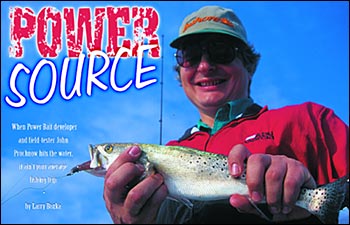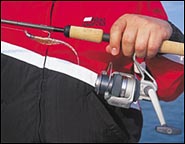
When Power Bait developer and field-tester
John Prochnow hits the water,
it ain't your average fishing trip
By Larry Bozka
Page 2
Capt. Holden is worried about the weather. But John Prochnow
is in field-tester's heaven.
"I spend at least 90 days a year field-testing lures,"
Prochnow tells me. "People ask me about it, and I tell them
that although it may sound like a fun-filled vacation, they shouldn't
think for a moment that it's a nonstop, action-filled adventure.
"Sure," he continues, "we're on the water, and
we're fishing. But for many test sessions, that's where the resemblance
ends. For one thing, rain or shine, testing goes on. If the captain
believes that the conditions are safe enough to fish, we keep
on testing."
I look over at Holden who, focused on the approaching weather,
remains silent. Prochnow makes another cast with the chartreuse-tailed
Power Jerk Shad.
 "The testing protocol that we follow does not always allow us to use the ideal bait for the conditions," Prochnow says.
"You have to remember that our labs are sometimes thousands
of miles away from the waters we are testing on. This," he
explains, "creates the problem of not having the most ideal
configuration of bait for the current conditions which, like now,
are constantly changing. It's not as easy as going down to the
local tackle shop and purchasing the right color or shape for
that day. The tests that we are running are with experimental
attractant packages and shapes that are custom-designed and formulated
in our research labs. We try to bring along as many variations
as possible, but there are limitations." "The testing protocol that we follow does not always allow us to use the ideal bait for the conditions," Prochnow says.
"You have to remember that our labs are sometimes thousands
of miles away from the waters we are testing on. This," he
explains, "creates the problem of not having the most ideal
configuration of bait for the current conditions which, like now,
are constantly changing. It's not as easy as going down to the
local tackle shop and purchasing the right color or shape for
that day. The tests that we are running are with experimental
attractant packages and shapes that are custom-designed and formulated
in our research labs. We try to bring along as many variations
as possible, but there are limitations."
Foremost among those limitations, Prochnow points out, are the
restrictions of air travel - luggage, how much you can carry and,
unfortunately, the ever-present possibility that it will be lost
in transit.
"Because of that," he says, "all experimental
test baits must be hand-carried. If the baits are lost, the test
is off. Imagine two to six field test anglers boarding a plane
with anywhere from 20 to 200 pounds of experimental baits. Some,
by the way, make Power Bait smell like candy in comparison. Most
of the other travelers aren't very appreciative of the odor, "
he adds with a chuckle, "but most of them get over it."
Next in the field-testing process comes meeting the boat captain
or guide. "Of course, they want to go out and catch lots
of fish for us," Prochnow says. " And that's exactly
what we require - lots of numbers of fish caught so as to determine
the best bait. When we inform them that we do not want the fish
biting too aggressively, though, that's when the questions begin."
"I thought you wanted to catch a lot of fish?"
"That's true," I tell them, "but we all know that
there are times when the fish - especially saltwater species - are
biting so well that an angler can literally catch them on a bare
hook. Catching fish in those conditions does not allow the data
to be accurate. It is what we in the scientific community call
'skewed data.' We are looking, rather, for fishing conditions
in which the fish are in a neutral to slightly positive feeding
mode.
"Captains tend to be puzzled when we state that slow fishing
conditions are ideal for testing. But for our tests, some of the
worst fish-catching conditions are the best testing conditions."
"Then it's about to get downright excellent," Holden
mutters from the stern. Prochnow grins at me, and makes another
cast. A 23-inch redfish slurps up the clear-bodied lure and Prochnow
sets the hook, obviously enjoying himself.
"Very dirty water conditions are generally tough for catching
fish," he says. "When we are testing attractant formulations
we want the fish to respond more by smell than by sight, and the
dirty water conditions force the fish to rely more on their sense
of smell. Fishing conditions aren't always the most comfortable
or conducive to catching fish, but don't misunderstand. We love
what we do.
"The challenge to design and produce new products that catch
more and larger fish when the conditions are less than ideal is
what motivates us. As anglers," Prochnow points out, "we
are not always able to fish under the best conditions. But we
still like to have fun catching fish, and that's what it is all
about - making sure the angler has a good experience whether he
or she is a first-time angler or an avid captain."
"This avid captain thinks it's time to go," Holden
says as the first raindrops begin to fall and he dons a slicker.
Prochnow lands his last speck, a fat 17-incher, and the drops
become a deluge.
"Hey," he says, "like I told you, if you do this
right it isn't always comfortable. But it sure is fun."
Indeed it is. And that ain't hype.
# # # #
page 1 / page 2
| 




